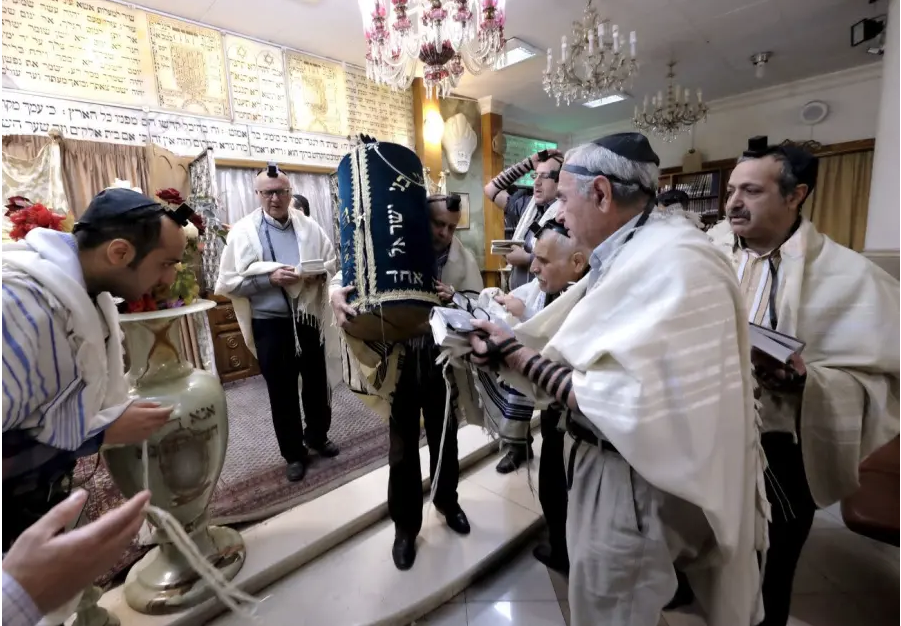Don’t passover a Persian Passover

By Jacqueline Saper
Persian Jews have lived in the Middle East for two-and-a-half millennia. As a result, they have adopted many of their countrymen’s customs and merged them with their own, rich, Jewish traditions. One of the best examples of this Persian-Jewish fusion is when Nowruz (the Iranian new year) and Passover intersect.
The Nowruz holiday takes place on the first day of spring (March 21) and is the most important festival in Iran. The preparations for the 13-day holiday begin weeks in advance when families clean their homes from top to bottom. The grueling task of cleaning and scrubbing every nook and cranny is known as khaneh takani meaning to shake the house. Everyone buys new clothes, and makes it a point to visit relatives and friends.
The Nowruz traditional table setting, known as the haft seen, is the center of the new year celebrations. Seven symbolic items, all beginning with the Farsi letter sheen, are placed on the table: sabze (green grown sprouts); samanu (sweet pudding); senjed (dried fruit of the oleaster tree); seer (garlic); seeb (apples); sumac (spice); and serkeh (vinegar). Also, colorful painted eggs, coins, fragrant hyacinths, goldfish and candles decorate the traditional spread.
Depending on the Iranian celebrants’ religious affiliation, excerpts from the Quran, Bible, Avesta or poetry books of renowned Persian poets such as Ferdowsi or Hafez are placed at the table. Traditional dishes served include rice with herbs, and white fish stuffed with walnuts and pomegranate, and garnished with tarragon, parsley and radishes. The most common food offered over pleasantries is dried fruits, pistachios, edible seeds and dates.
Just like Nowruz, the preparations for the eight-day Passover holiday, which also occurs in the spring, begin weeks in advance. Families clean their homes and remove the forbidden hametz (leavened foods).
The Passover traditional table setting, known as the Seder, is the center of the biblically derived holiday which retells the story of the Israelite’s freedom from bondage in Egypt. The Seder plate displays six symbolic items: matzah; zeroah (roasted lamb shank bone); maror (bitter herbs); beitzah (boiled egg); haroset, a mixture of chopped fruits and nuts; and karpas (greens such as parsley), that we dip in salt water. Four cups of wine are drunk during the banquet.
I have vivid memories of my childhood Seders in Iran. My father would don a tailored three-piece suit and read from the Haggada in a strong, commanding voice. We would read along and sing the traditional songs from our Farsi and Hebrew Haggadot. We ate grape leaves stuffed with rice and ground beef, grilled fish, roasted eggplant, saffron rice with barberry and slivered almonds, and chicken stew. Most delicious was the crispy golden tahdig, which is the crust of rice left to scorch at the bottom of the pan.
Now that I live in Chicago, our Seders have evolved again to incorporate Persian customs, as well as American and Ashkenazi Jewish customs. At our table, we read and sing from the Haggada in English, Hebrew and of course Farsi. My granddaughter’s custom-made Haggada references the American civil rights movement and highlights the similarities with the Jewish people’s quest for freedom.
We decorate our table with fresh flowers and fragrant hyacinths, and include a meal of herbed rice and white fish stuffed with walnuts and pomegranate, decorated with an assortment of fresh tarragon, parsley, and radishes. There is also brisket and matzah ball soup.
At the center of our table, lettuce replaces the horseradish, and vinegar replaces salt water. We fight over the delicious haleq (Persian haroset), which everyone demands to have an extra serving. At the recitation of the 10 plagues, we incorporate the Ashkenazi custom of dipping one’s finger in the wine with the Sephardi tradition of spilling drops of wine into a bowl.
The highlight of the evening is when we sing the traditional Passover song, Dayenu. In a uniquely Persian tradition, everyone grabs a scallion to fend off aggressive vegetables. This action is our way of remembering the “whipping” the Israelite slaves in Egypt received from their Egyptian masters.
Persian Jews mark the end of Passover, known as Shab-e Sal, with a meal composed of dairy products featuring a variety of yogurt and herb dishes. The day after the end of Passover, known as Ruz-e Sal, as well as the last day of Nowruz celebrations, known as sizdah bedar, are both spent in the outdoors and close to nature. If Lake Michigan weather permits, we try to spend this time with family at a park or the Botanic Gardens.
Passover is about celebrating our freedom with family and the community. So why don’t you find yourself a Persian American Jewish family and celebrate Passover with a twist?
Originally published in the Jerusalem Post at: https://www.jpost.com/Opinion/Dont-pass-over-a-Persian-Passover-585679
Read more from Jacqueline Saper at: https://www.jacquelinesaper.com/
Inspired to create
your own Haggadah?
Make your own Haggadah and share with other Seder lovers around the world
Have an idea
for a clip?
People like you bring their creativity to Haggadot.com when they share their ideas in a clip
Support Us
with your donation
Help us build moments of meaning and connection through
home-based Jewish rituals.
OUR TOP CONTRIBUTORS
Passover Guide
Hosting your first Passover Seder? Not sure what food to serve? Curious to
know more about the holiday? Explore our Passover 101 Guide for answers
to all of your questions.






















